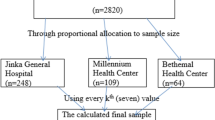Summary
In this study, we conducted an investigation among medical workers, patients and college students concerning their acceptability of breast palpation performed by male doctors (hereinafter referred to as “acceptability”, or “the examination”, respectively, if not otherwise indicated), to get the information about their acceptability and reasons for accepting or declining the examination among the three population. A questionnaire investigation was conducted in 500 patients with breast diseases, 700 students of medical colleges, and 280 medical workers working in hospitals. The subjects were asked to choose between two options: accept or do not accept (the examination). The subjects were asked to fill out the questionnaire forms on free and anonymous basis and the questionnaire forms were collected on spot, immediately after completion. The questionnaires collected were coded, sorted out and checked. Data of the eligible questionnaires were input into Epidata software and analyzed by SPSS. Upon the establishment of the database, the intra-group data were tested by utilizing χ2 test. Among 1480 questionnaires, 1293 (90.41%) questionnaires were retrieved. Our results showed that 56.78% of patients reported that they could accept breast palpation by male doctors. About 59.66% of medical staff expressed their acceptance of the examination, but only 35.03% of students said the examination. On the basis of this study, we were led to conclude that the examination is not well accepted by different populations, and therefore, (1) medical professionals and administrators should pay attention to the gender-related ethics in their practice and the feeling of patients should be respected when medical examinations involve private or sensitive body parts; (2) to this end, related departments should be properly staffed with doctors of both sexes, and this is especially true of the departments involving the examination or treatment of private or sensitive body parts; (3) health education should, among other things, include helping female patients to overcome the fear and anxiety in such examinations. This is of great importance since some women may miss the opportunity to get timely diagnosis.
Similar content being viewed by others
References
The Ministry of Health, the State Administration of Traditional Chinese Medicine. Opinions on implementing “patient- selecting-doctor” to promote internal reform of medical institutions. Chin Rural Health Manage (Chinese), 2000,20(8):13
LV Y. Present status of “patient-selecting-doctor”. J Psychol Doct (Chinese), 2012,6:416–417
Wang XY. Ethics significance of “patient-selecting- doctor”. Chin Med Ethics (Chinese), 2001,14(2):32–33
Hu SJ. Advantages and disadvantages of “patient- selecting-doctor”. Chin Med Ethics (Chinese), 2002,15(1): 44–45
Yin LY, Fu BE, Li FY. Efficacy of propofol in painless artificial abortion: an analysis of 5600 cases. Guide Chin Med: J Med (Chinese), 2005,3:2–3
He B, Zhou WW. Effects of the anesthetist gender on propofol dosage in painless abortion. Mod Med Health (Chinese), 2012,28(6):855–856
Cui Y. Adverse effects of propofol in painless artificial abortion. Hainan Medical J (Chinese), 2009,20(3):64–65
Alehagen S, Wijma B, Lundberg U, et al. Fear, pain and stress hormones during childbirth. J Psychosom Obstet Gynaecol, 2005,26(3):153–165
Tang Y, Nie X, Zhu GQ. Influence of preoperative anxiety on target controlled infusion anesthesia with propofol and fentanyl in patients undergoing painless artificial abortion. J Clin Anesthesiol (Chinese), 2009,25(2):140–141
Zeng M, Hu MN, Li H, et al. Discussion on the application of doctor-patient communication in mammography. Anhui Med J (in Chinese), 2011,32(9):1325
Ding SM, Zhang JE. Pressure during molybdenum target radiography of women after breast augmentation. J Practical Radiol (Chinese), 2007,23(11):1524–1525
Bricker SRW. Hallucinations after propofol. Anaesthesia, 1988,43(2):170–171
Saint-Mauriee C. Propofol in pediatric anesthesia. Cah Anesthesiol, 1991,39(6):411–420
Gong YL. Social medicine (Chinese). Beijing: People’s Medical Publishing House. 2001,11–25
Wang ZY, Xu XH, Zuo CC, et al. How to understand and carry out “patient-selecting-doctor”. Chin Health Serv Manage (Chinese), 2001,(3):147–149
Liu J. Face-to-face interaction between female patients and male doctors. Health Horizon, 2005,2:36–37
Gao H, He ZZ. “Patient-selecting-doctor” mode is important for the development of hospitals. Chin Health Serv Manage, 2001,22(3):l6–l7
Tao J, Cai QH. Thinking “patient-selecting-doctor” under new circumstances. Chin Hosp Manage (Chinese), 2011, 31(5):11–12
Yu J, Zhang MX, Jin JG, et al. Deepening and perfecting the “patient-selecting-doctor” mode. Chin Health Serv Manage (Chinese), 2002,18(6):340–342
Wu YM. Analysis of “patient-selecting-doctor”. Mod J Integr Tradit Chin West Med, 2002,11(15):1526–1527
Han J, Zheng PY. Analysis of patient mindset after “patient- selecting-doctor” and triage skills. J Qilu Nursing (Chinese), 2001,7(6):474–475.
Ou YX. Rational thinking in “doctor-selecting-patient”. Chin Lawyer (Chinese), 2002(4):63–64
Chen XL, Zhang SC. Some problems in implementation of “doctor-selecting-patient”. Chin Health Serv Manage (Chinese), 2001,17(2):82–83
Xu YH. Analysis of the pros and cons of “patient- selecting-doctor” and the countermeasures. Chin J Hosp Adm (Chinese), 2001,17(6):337–338
Yao W. Analysis of the disadvantages of “patient-selecting- doctor” and the countermeasures. Soft Sci Health (Chinese), 2000,14(6):292–293
Shen K, Yao W. Disadvantages of “patient-selecting-doctor” and the coping strategies. Chin Health Serv Manage (Chinese), 2001,17(11):660–661
Wang QG. Ethics about “patient-selecting-doctor”. Chin Med Ethics (Chinese), 2002,15(5):18
Zhang T. Informed consent right of patients and particular intervention of doctors. Chin Med Ethics (Chinese), 2001,(2):8–10
Fu J. Relationship between informed consent right of patients and leading decision-making power of physicians. Med Philos (Chinese), 2003,24(6):43–45
Xia YY. Misunderstanding of informed consent right from the perspective of the history of informed consent right. Soft Sci Health, 2007,21(2): 155–157
Luo JY, Zeng R. “Doctor-selecting-patient” and role conversion of doctors. J Chin Physician (Chinese), 2004,6(10): 1
Author information
Authors and Affiliations
Corresponding author
Additional information
This project was supported by a grant from the National High-tech R&D Program (Program 863) (No. 2011AA030101).
Rights and permissions
About this article
Cite this article
Wang, Yj., Yang, J., Kang, Lx. et al. Acceptability of physical examination by male doctors in medical care: Taking breast palpation as an example. J. Huazhong Univ. Sci. Technol. [Med. Sci.] 35, 781–784 (2015). https://doi.org/10.1007/s11596-015-1507-1
Received:
Revised:
Published:
Issue Date:
DOI: https://doi.org/10.1007/s11596-015-1507-1




